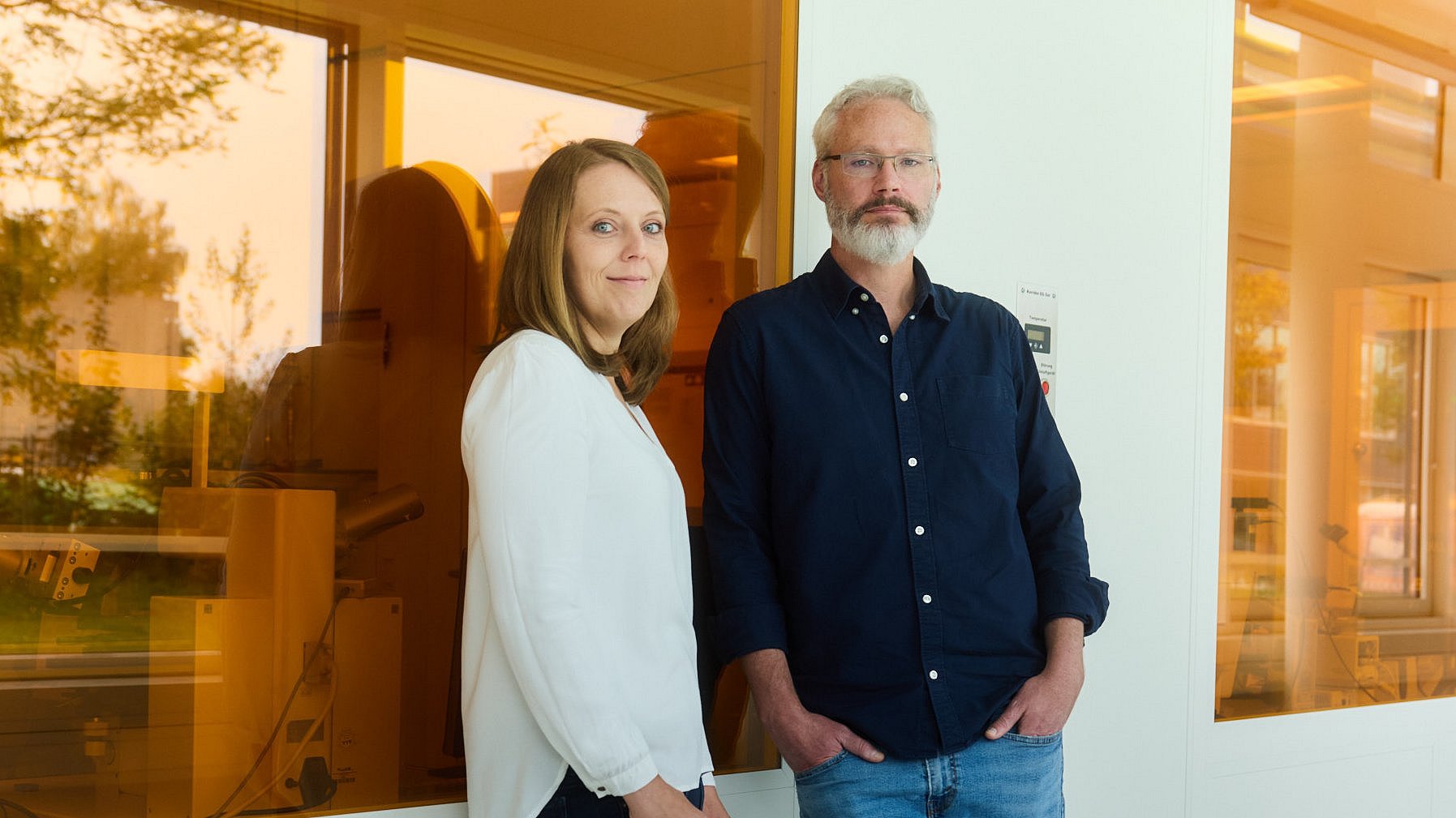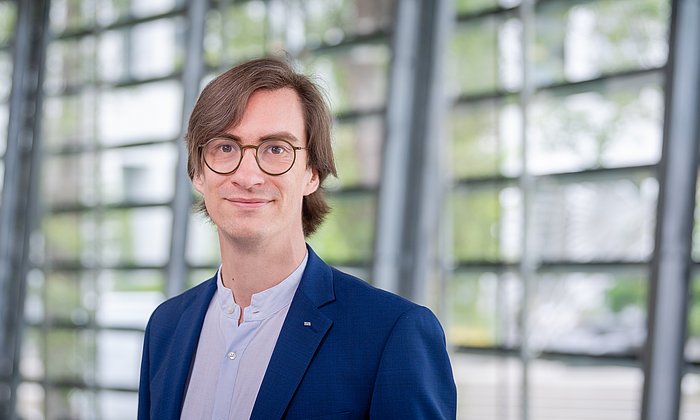E-conversion Cluster of Excellence
Mission: a human-made leaf
It’s 2040, and sparkling on the rooftops of apartment buildings, factories, and skyscrapers are the components of a revolutionary system that captures sunlight and extracts carbon dioxide (CO2) from the atmosphere. The components contain high-tech materials that generate solar power while making the energy available for chemical reactions. Dispensing with battery storage or other intermediate stages, the system converts climate-damaging carbon dioxide into green fuels such as hydrogen (H2) and important basic chemicals for industry. The only “waste” byproduct of the process is oxygen.
To bring this future vision closer to reality, researchers at the e-conversion Cluster of Excellence are emulating the principle of photosynthesis. Their research focuses on developing materials known as photocatalysts that have the required characteristics, and systems that function like artificial leaves.
Understanding and improving catalysts
The Sun sends around 944 million terawatt hours of energy to the Earth every year. A small fraction of that amount would cover all of our planet’s current energy needs. “At present, solar energy is used mainly to produce energy by heating water or to generate electricity in photovoltaic systems. Both of these forms of energy production can be used for industrial purposes in a second step,” explains Prof. Ian Sharp, a materials scientist at TUM and coordinator of the e-conversion Cluster of Excellence. “But photocatalysts can do more than that: they can provide solar energy directly to generate chemical reactions.”
Although natural photosynthesis is a source of inspiration for the researchers, they do not intend to copy it. It is a highly complex process and, with a conversion factor of around 1 percent, it is not particularly efficient. Although sufficient to make plants grow, the process falls far short of what would be needed for technical applications and commercial use. Consequently, the researchers are looking for materials and processes for the efficient and sustainable production of basic chemicals and energy sources. This would make an important contribution to the energy transition and drastically reduce the fossil fuel requirements of industry.
“To efficiently implement artificial photosynthesis in molecular form, we still have major hurdles to overcome. Catalytic processes will play a decisive role,” says Ian Sharp. In these processes, chemical reactions are accelerated by a substance—the catalyst—that is neither changed nor consumed.
"The focus of e-conversion is on interfaces, because this is where catalysts and reacting molecules meet." There are many gaps in knowledge at these interfaces that the researchers want to close. They are developing suitable materials and deciphering molecular and atomic catalysis processes. They are focusing primarily on semiconductor materials because they have special optical and electronic properties: They can capture light efficiently and use its energy to generate negative and positive charges in the semiconductor. This makes the energy of the light available for chemical reactions.
A major part of Ian Sharp and his team's research focuses on CO2 reduction. If this is successful, sunlight could be used to convert carbon dioxide into industrially important molecules such as hydrocarbons or alcohols. However, the concentration of CO2 in the air is low. “To make the conversion possible through catalysis, we have therefore developed a tailor-made nanocoating,” explains Prof. Sharp. “With this trick we increase the CO2 concentration at the catalytic surface and make the gas more reactive.” To convert the CO2 efficiently into a desired product in the next step, the perfect material is needed. An examination of the list of criteria for the material shows that it must be a true jack of all trades: it has to be long-lasting and chemically stable, but also capable of absorbing most of the visible spectrum efficiently and converting the energy into electrical charges. In addition, it must be able to catalyze only the desired chemical reaction and must not contain any toxic elements.
Utilizing nanoeffects
The periodic table offers an endless list of combinations. To speed up the search for new materials, the researchers are using high-throughput screenings and applying artificial intelligence to evaluate potential materials. “In addition, theoretical calculations deliver key indications of whether certain combinations of elements will be stable and will exhibit the desired optical characteristics,” says physicist Johanna Eichhorn. The professor at the TUM School of Natural Sciences uses various methods to create entirely new materials in the laboratory and characterize the physical principles underlying the energy conversion processes. One of her principal research interests is photoelectric performance. As she explains, “That’s how we describe how efficiently a material converts light into electrical energy,and at the same time we can observe the stability of a material.”
Nano effects often have a positive impact on the performance of a material.
However, the catalytic characteristics of a material are also determined to a large extent by its structure and physical properties. “We look very closely at the crystal structures, and especially areas that deviate from the regular patterns,” says Johanna Eichhorn. “These are often the docking points for molecules, and consequently the place where catalytic processes begin.” In addition, these irregularities in the crystal lattice influence the paths taken by electrons or “holes”—and, as a result, the reactions as well. To obtain a material profile with the greatest possible precision, the researcher uses a special scanning microscope to zoom down into the nanostructures on the semiconductor surfaces and map the local differences.
At the same time, the device gives her insights into the electronic characteristics—at the very same location. “In that way, we can correlate the structure and properties at a nanoscale level. That is extremely valuable because it gives us a macroscopic view of the effects,” explains the physicist. “In case after case, we see that nanoeffects can have a positive impact on the performance of a material. That is why basic research in this area is so important.” Ideally, Johanna Eichhorn would like to use the insights gained to improve the stability and efficiency of semiconductors for photocatalytic water splitting and, as a result, to optimize hydrogen production.
Emiliano Cortés is also conducting research into the impressive impact of nanoeffects. The physicist at the Nano Institute at the Ludwig-Maximilians-Universität München, who is leading one of the 53 research groups in the e-conversion Cluster, is developing so-called supercrystals. These are gold particles around 100 nanometers (nm) in diameter which have self-organizing properties and form tightly spaced and regular patterns on a surface at a distance of just 5 nm between particles. Known as plasmonic structures, these arrangements have special capabilities: they can act like powerful lenses to focus sunlight and absorb far more energy from the incoming light than a surface completely coated with gold. “Strong electrical fields called hotspots arise between the gold particles,” says Prof. Cortés. “When we place platinum nanoparticles at those precise locations, this generates a highly efficient conversion of formic acid into the energy source hydrogen.” This system has gained the group the current world record for rapid production of H2 using sunlight.
Decoding chemical reactions
The tiny platinum clusters are also at the center of the research conducted by Ulrich Heiz’ team at TUM. The professor of physical chemistry wants to determine the ideal number of platinum atoms needed by a nanoparticle for the efficient production of hydrogen. “Along with making it possible to produce the catalytically active clusters to atomic-level accuracy, our high-tech equipment helps us to study how to optimize their position on a surface,” explains the researcher. The systematic studies at the e-conversion Cluster of Excellence have also revealed that photochemical reactions follow different rules than previously assumed.
“We have discovered that the long-familiar patterns that govern electrochemical processes, for example, do not apply to photocatalysis. Photochemistry opens up entirely new reaction pathways,” says Prof. Heiz. Those who know and understand them will be able to discover, customize, or design suitable materials. “Every new piece of knowledge improves our understanding of photocatalysis and thus brings us incrementally closer to a real-world application,” he says. “The e-conversion teams are applying multi-layered approaches, delving deep into the wealth of ideas in various specialized fields, and are extremely well networked. This is an excellent basis for innovation.”
-
Find out more about energy research at our university at tum.de/energy.
-
E-conversion is currently one of four Clusters of Excellence at TUM.
This article was published in the 01/2025 issue of the new TUM Magazine.
Technical University of Munich
Corporate Communications Center
- Dr. Caroline Zörlein / Andreas Schmidt
- a.schmidt@tum.de
- presse@tum.de
- Teamwebsite
Contacts to this article:
Prof. Dr. Ian Sharp
Professorship for Experimental Semiconductor Physics
TUM School of Natural Sciences
ian.sharp(at)tum.de








